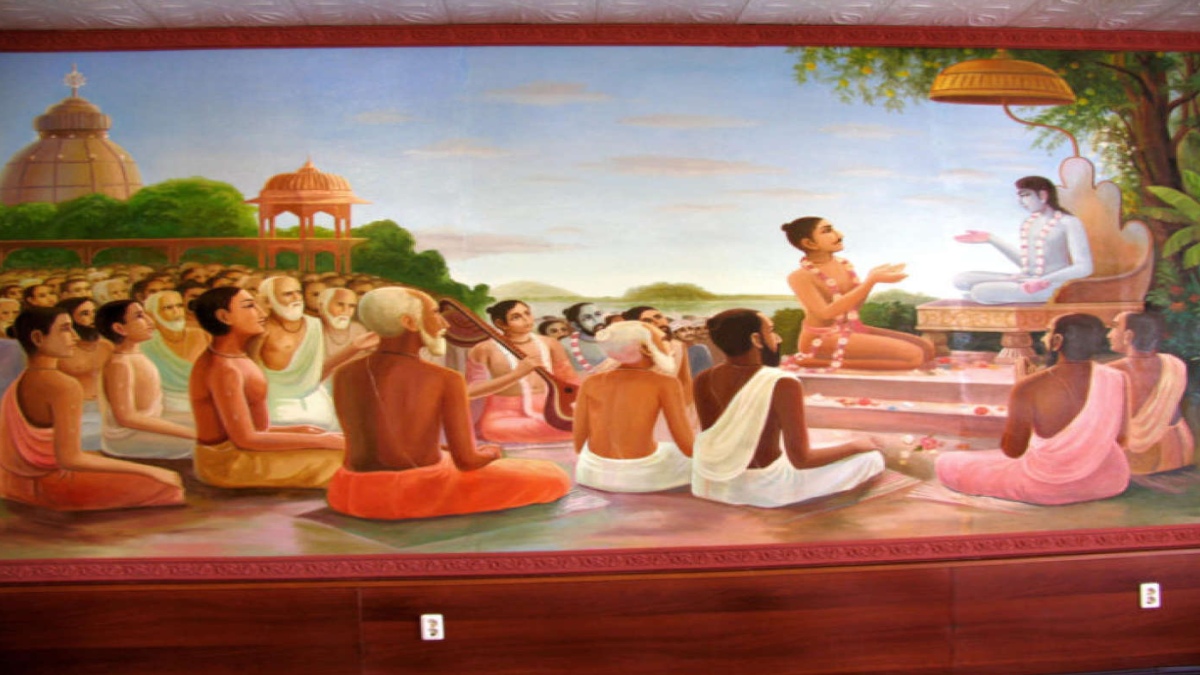
The Sanskrit word Sanatana means “eternal” and the word Dharma means “occupation.” Therefore the term “Sanatana Dharma” can be taken to mean our eternal occupation. The Supreme Lord and His transcendental abode are both Sanatana, eternal, as are the living entities, and the combined association of the Supreme Lord and the living entities in the Sanatana abode (the spiritual world) is the perfection of human life.
Krishna is very kind to the living entities because they are His sons. Krishna declares in the Bhagavad Gita that, “I am the father of all.” There are many different types of living entities according to their different karma, and Krishna declares He is the father of them all. Therefore, time and time again, the Lord descends to this material world to reclaim all of these fallen, conditioned souls to call them back to the Sanatana, eternal, sky so that the Sanatana living entities may regain their original eternal positions in association with the Lord. Thus Krishna comes in different incarnations, or He sends His confidential servants as sons or acharyas to reclaim the conditioned souls.
Therefore Sanatana Dharma does not refer to any sectarian process of religion. It is the eternal function of the eternal living entities in relationship with the eternal Supreme Lord. Sanatana Dharma refers, as stated previously, to the eternal occupation of the living entity.
The English word “religion” is a little different from Sanatana Dharma. Religion conveys the idea of faith, and faith may change. One may have faith in a particular process, and he may change this faith and adopt another, but Sanatana Dharma refers to that activity that cannot be changed. For instance, liquidity cannot be taken from the water, nor can heat be taken from fire. Similarly, the eternal function of the eternal living entity cannot be taken from the living entity. Sanatana Dharma is eternally integral to the living entity. When we speak of Sanatana Dharma, then, we must take it for granted that it has no beginning or end.
That which has neither beginning nor end cannot be sectarian, for it cannot be limited by any boundaries. Yet those belonging to some sectarian faith will wrongly consider that Sanatana Dharma is also sectarian, but if we go deeper into the matter and consider it in the light of modern science, we can see that Sanatana Dharma is the business of all people of the world–nay, of all the living entities of the universe. Non-Sanatana religious faith may have some beginning in the annals of human history, but there is no beginning to the history of Sanatana Dharma because it remains eternally with the living entities.
The Bhagavad Gita states that the living entity has neither birth nor death, he is eternal and indestructible, and he continues to live after the destruction of his temporary material body.
To understand the concept of Sanatana Dharma, we must first try to understand the concept of religion from the Sanskrit root meaning of the word. Dharma refers to that which constantly exists with the particular object. We conclude that there is heat and light along with the fire; without heat and light, there is no meaning to the word fire. Similarly, we must discover the essential part of the living being, that part which is his constant companion. That constant companion is his eternal quality, and that eternal quality is his eternal religion.
When Sanatana Gosvami asked Sri Caitanya Mahaprabhu about the constitutional position of the living being He replied that it is the rendering of service to the Supreme Personality of Godhead. If we look at what is happening around us in the world we can easily see every living being is constantly engaged in rendering service to another living being. We can see that one friend serves another friend, the mother serves the son, the wife serves the husband, the husband serves the wife and so on. If we go on searching in this spirit, it will be seen that there is no exception in the society of living beings to the activity of service. The politician presents his manifesto for the public to convince them of his service capacity. The voters, therefore, give the politician their valuable votes, thinking that he will render valuable service to society. The shopkeeper serves the customer, and the artisan serves the capitalist. The capitalist serves the family, and the family serves the state. In this way, we can see that no living being is exempt from rendering service to other living beings, and therefore we can safely conclude that service is the constant companion of the living being and that the rendering of service is the eternal religion of the living being.
Factually we are related to the Supreme Lord in service. The Supreme Lord is the supreme enjoyer, and we living entities are His servitors. We are created for His enjoyment, and if we participate in that eternal enjoyment with the Supreme Personality of Godhead, we become happy. We cannot become happy otherwise. It is not possible to be happy independently, just as no one part of the body can be happy without cooperating with the stomach. It is not possible for the living entity to be happy without rendering transcendental loving service unto the Supreme Lord. Therefore, to summarise, the Sanatana Dharma of every living entity is the rendering of service. No matter what religion one professes to belong to, this eternal occupation of rendering service remains with the living entity. To perfect one’s life, one simply requires the redirection of this service. Instead of serving in the material world, he can serve Krishna, the Supreme Personality of Godhead. This process, transforming one’s service from persons and objects in the material world to the service of Krishna in the spiritual world, is the art of Krishna consciousness and as we progress in this newsletter we will discover how we can easily transform seemingly material activities into liberating transcendental activities, by performing them for the pleasure of Krishna.
Gauranga Sundar Das is Iskconinc Communication Director and SM IT Head.















